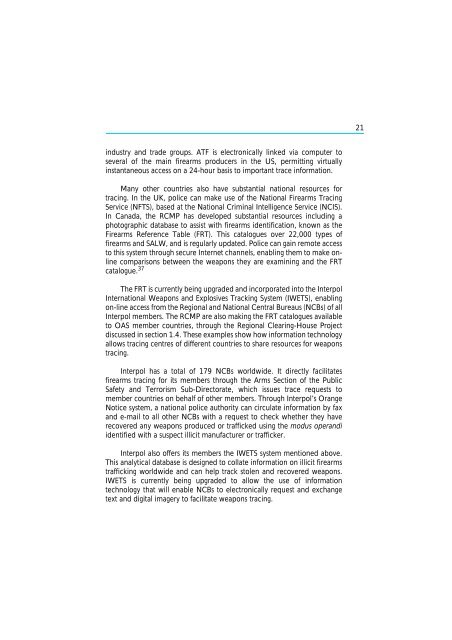The Scope and Implications of a Tracing Mechanism for Small Arms ...
The Scope and Implications of a Tracing Mechanism for Small Arms ...
The Scope and Implications of a Tracing Mechanism for Small Arms ...
Create successful ePaper yourself
Turn your PDF publications into a flip-book with our unique Google optimized e-Paper software.
21<br />
industry <strong>and</strong> trade groups. ATF is electronically linked via computer to<br />
several <strong>of</strong> the main firearms producers in the US, permitting virtually<br />
instantaneous access on a 24-hour basis to important trace in<strong>for</strong>mation.<br />
Many other countries also have substantial national resources <strong>for</strong><br />
tracing. In the UK, police can make use <strong>of</strong> the National Firearms <strong>Tracing</strong><br />
Service (NFTS), based at the National Criminal Intelligence Service (NCIS).<br />
In Canada, the RCMP has developed substantial resources including a<br />
photographic database to assist with firearms identification, known as the<br />
Firearms Reference Table (FRT). This catalogues over 22,000 types <strong>of</strong><br />
firearms <strong>and</strong> SALW, <strong>and</strong> is regularly updated. Police can gain remote access<br />
to this system through secure Internet channels, enabling them to make online<br />
comparisons between the weapons they are examining <strong>and</strong> the FRT<br />
catalogue. 37<br />
<strong>The</strong> FRT is currently being upgraded <strong>and</strong> incorporated into the Interpol<br />
International Weapons <strong>and</strong> Explosives Tracking System (IWETS), enabling<br />
on-line access from the Regional <strong>and</strong> National Central Bureaus (NCBs) <strong>of</strong> all<br />
Interpol members. <strong>The</strong> RCMP are also making the FRT catalogues available<br />
to OAS member countries, through the Regional Clearing-House Project<br />
discussed in section 1.4. <strong>The</strong>se examples show how in<strong>for</strong>mation technology<br />
allows tracing centres <strong>of</strong> different countries to share resources <strong>for</strong> weapons<br />
tracing.<br />
Interpol has a total <strong>of</strong> 179 NCBs worldwide. It directly facilitates<br />
firearms tracing <strong>for</strong> its members through the <strong>Arms</strong> Section <strong>of</strong> the Public<br />
Safety <strong>and</strong> Terrorism Sub-Directorate, which issues trace requests to<br />
member countries on behalf <strong>of</strong> other members. Through Interpol’s Orange<br />
Notice system, a national police authority can circulate in<strong>for</strong>mation by fax<br />
<strong>and</strong> e-mail to all other NCBs with a request to check whether they have<br />
recovered any weapons produced or trafficked using the modus oper<strong>and</strong>i<br />
identified with a suspect illicit manufacturer or trafficker.<br />
Interpol also <strong>of</strong>fers its members the IWETS system mentioned above.<br />
This analytical database is designed to collate in<strong>for</strong>mation on illicit firearms<br />
trafficking worldwide <strong>and</strong> can help track stolen <strong>and</strong> recovered weapons.<br />
IWETS is currently being upgraded to allow the use <strong>of</strong> in<strong>for</strong>mation<br />
technology that will enable NCBs to electronically request <strong>and</strong> exchange<br />
text <strong>and</strong> digital imagery to facilitate weapons tracing.
















